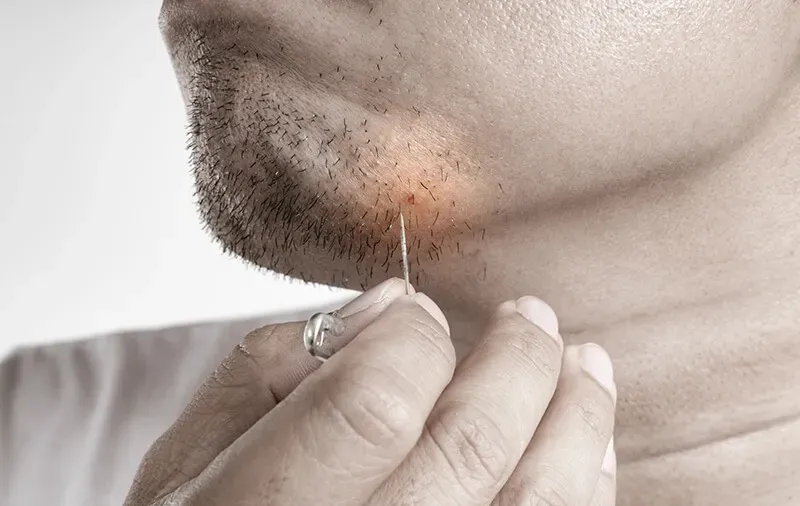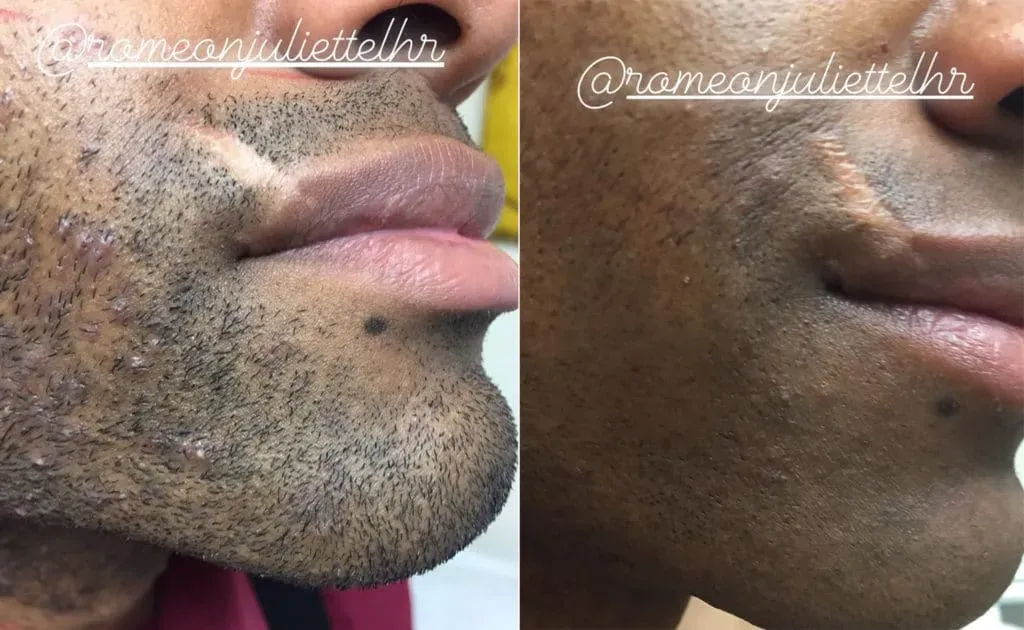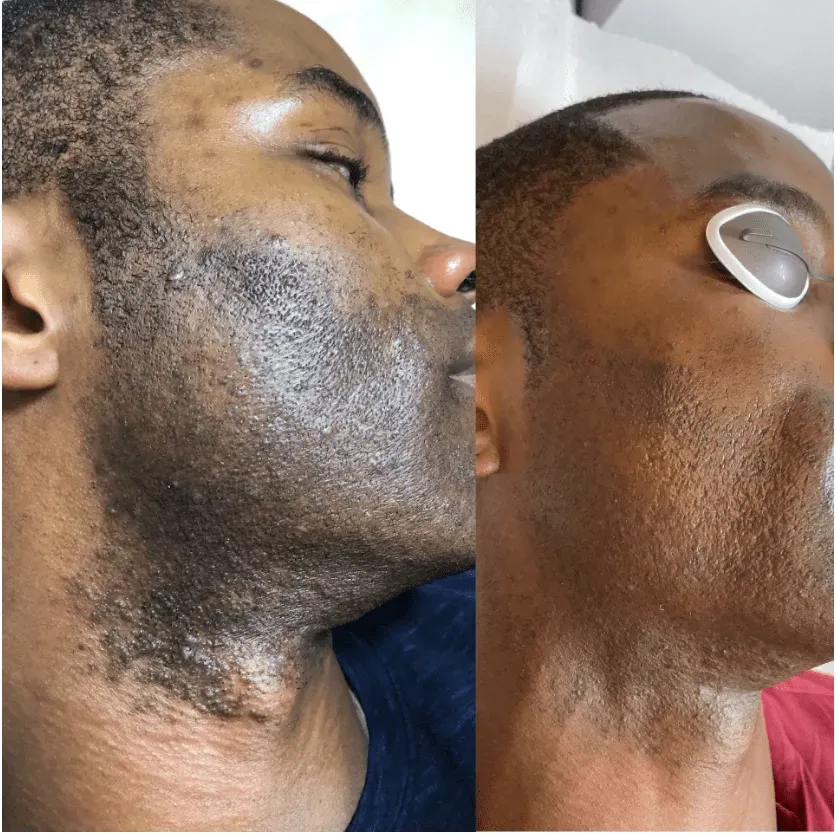Table of Contents
Let's be honest, facial ingrown hairs are the uninvited guests nobody wants. They pop up unexpectedly, causing redness, bumps, and sometimes outright pain. It’s a frustrating cycle, especially when you’re trying to maintain a smooth, clear complexion. You shave, you wax, you pluck, and then boom – there it is, a stubborn hair trapped beneath the skin, making its presence known in the most annoying way possible. Dealing with these little rebels can feel like a constant battle, leaving you searching for answers that actually work.
Understanding Facial Ingrown Hair and Why It Happens

Understanding Facial Ingrown Hair and Why It Happens
What Exactly Are Facial Ingrown Hairs?
so you've got this little red bump on your face, often looking suspiciously like a pimple, but it’s not quite right. That, my friend, is likely a facial ingrown hair. Think of it like a hair that got confused on its way out. Instead of growing straight up and out of the skin's surface, it curls back down or grows sideways into the skin. Your body sees this trapped hair as a foreign invader and responds with inflammation – that’s where the redness, swelling, and sometimes pus come from. It's a classic case of a hair shaft gone rogue.
This happens most often after hair removal methods like shaving, waxing, or plucking. When the hair is cut or pulled out, the new growth can sometimes get trapped under the skin's surface layer. Dead skin cells can also play a role, blocking the follicle opening and forcing the hair to grow inward. It's not just a cosmetic annoyance; it can be genuinely painful and, left untreated, can sometimes lead to infection or scarring. Understanding facial ingrown hair means recognizing it's a common issue, but also one that signals something is preventing the hair from exiting cleanly.
Common Culprits Behind Facial Ingrown Hairs
So, why does this keep happening, especially on your face? Several factors increase your chances of getting facial ingrown hairs. Shaving is a major one. When you shave, you create a sharp tip on the hair. This sharp tip can easily pierce the skin and grow back in. Using a dull razor, shaving too closely, or shaving against the grain makes this even more likely. Coarse or curly hair types are also more prone to ingrown hairs because the hair naturally tends to curl back towards the skin as it grows.
Tight clothing or friction can irritate the skin and push hairs back in, though this is less common on the face unless you're wearing something like a tight helmet strap regularly. Poor exfoliation is another factor. If dead skin cells build up, they can block the hair follicle opening, forcing the hair to reroute under the skin. Sometimes, it's just the way your hair grows or the angle at which it exits the skin. Knowing these common causes is the first step in figuring out how to prevent the problem from recurring.
- Shaving too closely or against the grain
- Using dull razor blades
- Coarse or curly hair texture
- Lack of regular exfoliation
- Blocked hair follicles
Effective Facial Ingrown Hair Removal Methods

Effective Facial Ingrown Hair Removal Methods
Alright, let's get down to brass tacks. You've got the bumpy problem, now you need the solution. Finding effective facial ingrown hair removal methods is key to getting your skin back on track. Forget digging at it with whatever sharp object you find first – that's a fast track to infection and scarring. The goal is to help the hair break free without causing more trauma to the skin. This often involves a combination of gentle techniques to coax the hair out and keep the area clean. Patience is your friend here; aggressive tactics usually backfire spectacularly. We're looking for methods that are targeted and minimize irritation, especially on the sensitive skin of the face.
So, what are your options when a stubborn hair decides to set up camp under your skin? Different approaches work for different people and different types of ingrowns. Sometimes a simple warm compress is enough to open the pore and allow the hair to emerge. Other times, you might need a bit more intervention. The key is to be sterile and gentle. Think of it as delicate surgery, not an excavation project. Using clean tools and preparing the skin properly can make all the difference between a quick fix and a lingering problem.
Here are a few common approaches people try:
- Warm Compress: Applying a warm, damp cloth to the area helps soften the skin and open the follicle.
- Gentle Exfoliation: Using a mild scrub or an alpha hydroxy acid (AHA) product can help remove dead skin cells blocking the hair. Don't scrub aggressively!
- Sterile Needle or Tweezers: ONLY use this method if the hair loop is visible above the skin. Sterilize the tool thoroughly with rubbing alcohol. Gently lift the loop of hair – do NOT pull the hair out completely if you can avoid it initially, just free the end from the skin.
- Topical Treatments: Over-the-counter creams containing salicylic acid or glycolic acid can help reduce inflammation and exfoliate the skin.
Preventing Future Facial Ingrown Hair Issues

Preventing Future Facial Ingrown Hair Issues
Mastering Your Shave Technique
so you've dealt with the current batch of ingrowns. Now the mission shifts to stopping them from coming back. Preventing Future Facial Ingrown Hair Issues starts with how you remove hair in the first place, especially if you shave. Think about it – the razor is often the main culprit creating those sharp, inward-bound hair tips. The first rule is simple but often ignored: always use a sharp, clean razor blade. A dull blade requires more pressure, leading to a closer, more irritating shave that cuts the hair at a bad angle.
Prepare your skin properly before the blade touches it. Use warm water or a warm towel to open up the pores and soften the hairs. Apply a good quality shave gel or cream – not just soap – that creates a slick surface for the razor to glide over. When you shave, go with the grain, not against it. Yes, you might not get that perfectly baby-smooth feel the first time, but it significantly reduces the chance of the hair curling back. Rinse your blade often and don't go over the same area multiple times. This minimizes irritation and gives the hair a better chance of growing out straight.
Post-Shave Care and Skin Routine
What happens after you shave is just as important for preventing future facial ingrown hair issues. Rinse your face with cool water to close the pores. Gently pat your skin dry – don't rub it raw. Follow up with a soothing, non-comedogenic aftershave or moisturizer. Look for ingredients that calm the skin and don't clog follicles. Salicylic acid or glycolic acid in low concentrations can be helpful here, gently exfoliating the skin and keeping the follicle opening clear.
Regular, gentle exfoliation a few times a week (but not immediately after shaving) helps remove dead skin cells that can trap hairs. You can use a chemical exfoliant (like a gentle AHA or BHA) or a soft brush. Consistency is key. If you're constantly battling severe ingrowns, especially on your face, it might be time to consider longer-term solutions like laser hair removal. Places like hairawaybylaser.com offer services that can drastically reduce hair growth, thereby reducing the source of the problem. It's a different approach, but for some, it's the only thing that truly breaks the cycle.
Prevention Checklist:
- Use a sharp, clean razor blade
- Prepare skin with warm water/towel
- Use quality shave gel/cream
- Shave with the grain
- Rinse blade frequently
- Avoid multiple passes over the same area
- Rinse with cool water post-shave
- Use soothing, non-comedogenic aftershave/moisturizer
- Gently exfoliate regularly (but not right after shaving)
- Consider laser hair removal for persistent issues
When to Seek Professional Help for Facial Ingrown Hair

When to Seek Professional Help for Facial Ingrown Hair
Sometimes, despite your best efforts with warm compresses and gentle exfoliation, a facial ingrown hair decides it's going to be a major problem. You'll know it's gone beyond a simple nuisance when the area becomes significantly more painful, red, and swollen than usual. Look for signs of infection: increasing tenderness, warmth, visible pus, or red streaks spreading from the bump. If the ingrown hair is deep, large, or keeps recurring in the same spot, leading to hyperpigmentation or scarring, it's a clear signal that home remedies aren't cutting it. This is precisely When to Seek Professional Help for Facial Ingrown Hair. Dermatologists or trained estheticians have the sterile tools and expertise to safely extract stubborn ingrowns, manage infection if present, and recommend more advanced treatments or preventative strategies tailored to your specific skin and hair type. Trying to play doctor on an infected or deeply embedded ingrown can make things much, much worse.
Finally Free from the Stubborn Struggle
So there you have it. Dealing with facial ingrown hair isn't some ancient mystery; it's usually a straightforward consequence of how hair grows and how we remove it. We've gone through the 'why,' the 'how-to-get-rid-of-it,' and the 'how-to-stop-it.' It might take some trial and error to find the best approach for your specific situation, but ignoring the problem usually doesn't make it disappear. By understanding the process and implementing consistent care, you can significantly reduce those irritating bumps and redness. It's less about magic cures and more about smart habits. Take what you've learned, give it a shot, and aim for smoother skin.
